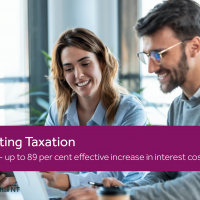Obtain expert advice before varying PAYG instalments
The PAYG instalment system (i.e. the system for making regular payments towards the expected annual income tax liability of a taxpayer) only applies to businesses or individuals earning business and/or investment income above a certain amount.
The ATO calculates the PAYG instalment rate based on the information reported on the latest tax return and if this calculated rate results in too much tax being paid, the business or individual will receive a refund of any overpayment once their tax return is assessed. Conversely, if insufficient PAYG instalments have been paid, a tax liability for the difference will arise.
If a taxpayer’s circumstances change in the current income year compared to the information in the prior year’s tax return (e.g. a current year may not be as profitable as the previous year) the taxpayer may want to lower their PAYG instalments for the current year.
However, if such a downward variation results in a greater than 15% shortfall of the actual amount of tax payable when the current year’s tax return is assessed by the ATO (i.e. there was an underestimate of the instalment rate or amount for the current year), the taxpayer may be subject to the general interest charge (GIC) on the difference. Therefore, a reasonable degree of certainty of the changed circumstances must exist before varying the ATO’s PAYG instalment rate.
As a general observation, most people prefer to pay PAYG quarterly instalments as they earn their income similar to an employee who has PAYG withholding tax deducted from their salary. The benefit of the PAYG instalment and withholding systems is that a large tax bill at the end of the income year, and the consequent need to find the cash to pay the bill, is avoided.
We recommend that you contact us before varying a PAYG instalment to avoid unnecessary penalties.
Specific deductions available for primary producers
Primary producers can claim specific capital expenditure deductions for:
- Electricity and phone connections (e.g. claim deduction over 10 years for capital expenditure on connecting electricity or telephone lines);
- Landcare / managing environmental issues (deduction also available for a lessee of the land)
- Shelterbelts / a line of trees or shrubs planted to protect an area from fierce weather (but no deduction would be available if the shelterbelt was only planted to protect a home – such costs must be included in the cost base of the land for CGT purposes)
Please come and talk to us if you would like to know more about potential incentives that may be available for primary production businesses.
ATO Warning : Watch out for scams
The ATO is warning against emails purporting to be from the ATO whereby scammers ask for your personal details or offer you a tax refund.
If you receive any such suspicious emails claiming to be from the ATO, please do not provide them with any information or open any attachment. In such a case, please contact us as soon as possible so that we can bring this to the attention of the authorities.
How can Nexia Edwards Marshall NT help you?
For any questions or to discuss any of the above in relation to your personal situation, please contact Sarah McEachern or your Nexia Edwards Marshall NT Advisor.


